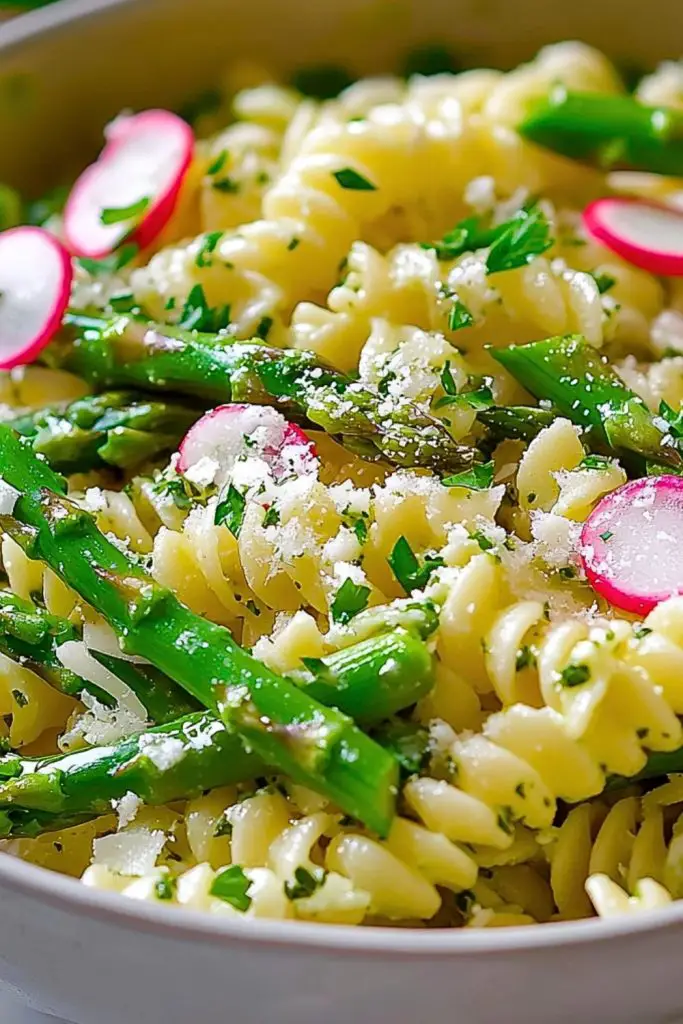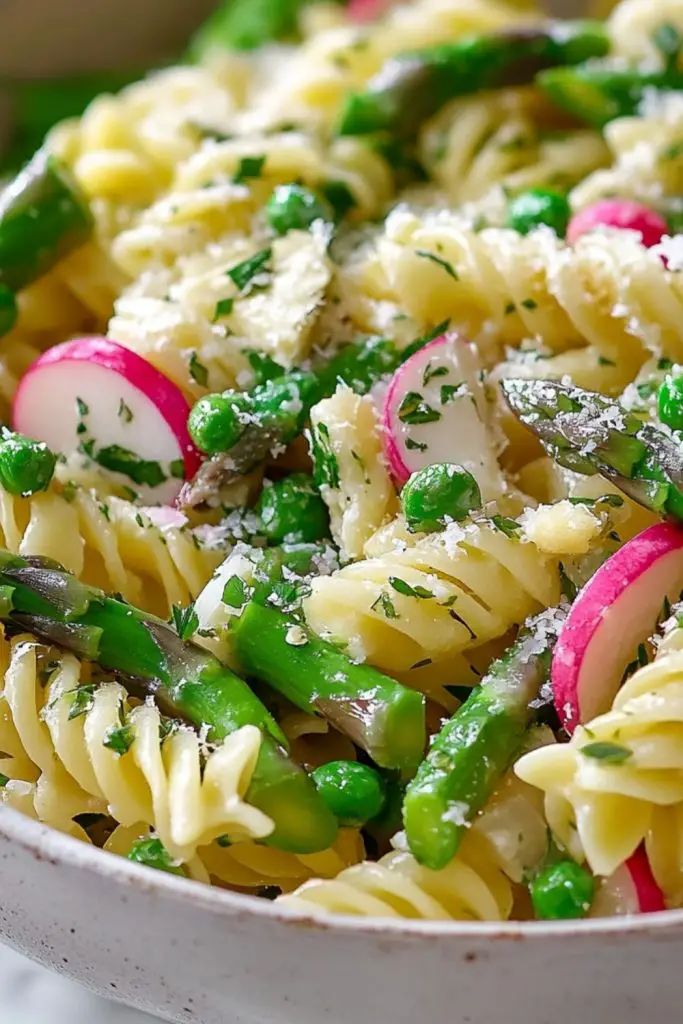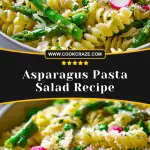Spring and summer call for dishes that feel fresh, vibrant, and effortless—and this Asparagus Pasta Salad delivers all that and more. I’ve always had a soft spot for recipes that can work equally well for a laid-back lunch or a crowd-pleasing side at a barbecue. This one does both with grace. The sweet crunch of snap peas, the subtle bite of radishes, tender asparagus, and perfectly cooked pasta make it a dish I keep coming back to whenever asparagus is in season.

I love how adaptable it is. It’s vegetarian, packed with green goodness, and tossed with a light lemon-herb dressing that brightens up every bite. It’s simple enough to throw together on a weekday but impressive enough for guests. Whether you serve it warm, room temp, or chilled straight from the fridge, it’s a flavorful, textural treat.
Why You’ll Love This Asparagus Pasta Salad Recipe
- Packed with spring veggies – Asparagus, peas, and radishes bring seasonal freshness.
- Quick and simple – It comes together in under 30 minutes.
- Perfect for any occasion – Serve it at potlucks, picnics, or as a light dinner.
- Customizable – Add cheese, herbs, or proteins to make it your own.
- Great for leftovers – Tastes just as good the next day!
What Kind of Pasta Works Best in Asparagus Pasta Salad?
When it comes to pasta salads, shape matters more than you’d think. I like to use short pasta with plenty of grooves—think fusilli, rotini, or farfalle. These shapes are perfect for catching the lemony dressing and clinging onto those little peas and chopped herbs. Fusilli, in particular, is my go-to because it holds its shape well after cooling and has a great bite that stands up to the tender veggies.
Avoid long, thin pasta like spaghetti or linguine for this salad. They don’t mix as well with chunky ingredients and tend to clump once chilled. You want something you can scoop up easily with a fork and get a bit of everything in one bite.
Options for Substitutions
Even though the recipe shines as-is, it’s incredibly flexible if you need to work with what you’ve got on hand or cater to dietary needs. Here are some great substitution ideas:
- Pasta: Use gluten-free pasta, chickpea pasta, or whole wheat for more fiber.
- Asparagus: Swap with blanched green beans, broccoli florets, or zucchini ribbons if asparagus isn’t in season.
- Radishes: Try thinly sliced cucumbers or shredded carrots for crunch.
- Peas: Edamame or chopped snap peas make great stand-ins.
- Cheese: Feta adds saltiness, but goat cheese, shaved parmesan, or even a dairy-free alternative work well.
- Herbs: Parsley is fresh and classic, but mint, basil, or dill can change the flavor profile beautifully.
- Dressing: No lemon? Use white wine vinegar or apple cider vinegar for a similar zing.
Ingredients for This Asparagus Pasta Salad Recipe
Each ingredient in this recipe plays a specific role—either adding texture, flavor, or that irresistible freshness that makes it such a standout spring or summer dish.
- Fusilli Pasta – The spiral shape captures the dressing and mingles perfectly with chopped vegetables.
- Fresh Asparagus – Lightly blanched for tenderness with a mild earthy flavor that anchors the dish.
- Green Peas – Sweet and delicate, they add pops of color and a pleasant bite.
- Radishes – Thinly sliced for crunch and a peppery edge that brightens up the bowl.
- Feta Cheese – Creamy and tangy, it balances the veggies and adds a savory punch.
- Fresh Parsley – Brings a fresh, herbaceous lift and ties all the flavors together.
- Lemon Juice – The acid in the dressing enhances the greens and keeps things zesty.
- Olive Oil – Smooths out the dressing and helps it coat the pasta evenly.
- Dijon Mustard – Adds depth and emulsifies the dressing for a silky texture.
- Salt and Pepper – Essential for seasoning and bringing out the full spectrum of flavors.

Step-by-Step Instructions for Asparagus Pasta Salad Recipe
Step 1: Cook the Pasta
Bring a large pot of salted water to a boil. Add the fusilli and cook until al dente, according to the package instructions. Drain and rinse under cold water to stop the cooking process and cool the pasta down. Set aside.
Step 2: Blanch the Asparagus and Peas
In the last 2 minutes of the pasta cooking time, toss in the chopped asparagus and peas. This will soften them just enough while keeping their vibrant green color and a little snap. Drain everything together and rinse under cold water.
Step 3: Prepare the Dressing
In a small bowl or jar, whisk together freshly squeezed lemon juice, olive oil, Dijon mustard, salt, and black pepper. Taste and adjust the seasoning as needed. This dressing is light and bright—perfect for spring veggies.
Step 4: Assemble the Salad
In a large mixing bowl, combine the cooled pasta, blanched vegetables, thinly sliced radishes, and chopped parsley. Drizzle over the lemon dressing and toss gently to coat everything evenly.
Step 5: Add Cheese and Chill (Optional)
Crumble feta cheese over the salad and give it a final toss. For best flavor, chill the salad for at least 20–30 minutes before serving. This lets the flavors meld beautifully.
How Long to Cook the Asparagus Pasta Salad
This dish is truly quick and easy to prepare, perfect for busy weeknights or last-minute get-togethers.
- Pasta cooking time: Typically 8–10 minutes (check your package for specifics).
- Asparagus and peas blanching time: 2 minutes (added to the pasta pot during the final stage of boiling).
- Total prep time: About 20 minutes.
- Optional chill time: 20–30 minutes if serving cold.
Altogether, you can have this salad on the table in under 30 minutes, or let it chill for a bit if you’re preparing ahead for a gathering.
Tips for Perfect Asparagus Pasta Salad
- Salt your pasta water well – It’s your first layer of flavor and helps elevate the overall taste.
- Don’t overcook the vegetables – You want the asparagus and peas tender-crisp, not mushy.
- Cool the pasta and veggies quickly – Rinse them under cold water to stop cooking and preserve that fresh color and texture.
- Balance your acidity – Taste the dressing before tossing. If it’s too sharp, add a bit more olive oil or a tiny pinch of sugar.
- Chill if you can – Giving the salad time to rest in the fridge allows the flavors to meld together more deeply.
- Use fresh lemon juice – It makes a difference in brightness and taste versus bottled juice.
- Add cheese last – Stir in the feta right before serving to prevent it from dissolving into the dressing.
- Serve at room temp for best flavor – If chilled, let it sit out for 10 minutes before serving so the flavors shine.
Watch Out for These Mistakes While Cooking
Even a simple salad like this can go sideways if you’re not careful. Here’s what to avoid:
- Overcooking the pasta: Mushy pasta ruins the texture of the salad. Aim for al dente.
- Forgetting to salt the pasta water: Unsalted water means bland pasta, and no amount of dressing will fix that.
- Skipping the ice bath or cold rinse: Without quickly cooling the veggies, you risk losing their vibrant green color and crisp bite.
- Adding the dressing too early: If you dress the pasta while it’s still hot, it can soak up too much dressing and dry out later.
- Using bottled lemon juice: Fresh lemon juice gives the best zing and freshness—bottled versions tend to taste flat.
- Not tasting as you go: Always check your dressing before adding, and taste the salad before serving. Adjust salt, lemon, or olive oil as needed.
- Overloading with feta: Too much cheese can overpower the fresh vegetables. Sprinkle lightly, taste, and adjust.
- Letting it sit too long with dressing: If making ahead, consider storing the dressing separately and tossing just before serving.
What to Serve With Asparagus Pasta Salad?
This pasta salad is incredibly versatile. Whether you’re building a picnic spread or creating a balanced dinner, it pairs beautifully with many dishes.
Grilled Chicken
Adds protein and a smoky depth—perfect for a light yet satisfying meal.
Seared Salmon
The richness of salmon complements the brightness of the salad, making it a luxurious duo.
Veggie Skewers
Roasted or grilled veggies like bell peppers, mushrooms, and zucchini keep it fresh and colorful.
Quiche or Frittata
Ideal for brunch. The creamy egg dish pairs well with this fresh, lemony salad.
Crusty Bread
A slice of sourdough or focaccia is perfect for scooping up every last bite of the salad.
Deviled Eggs
Great for picnics or potlucks—classic, bite-sized, and always a hit.
Grilled Shrimp
Quick to make, and the delicate seafood flavor pairs naturally with spring vegetables.
Soup on the Side
A light vegetable or chicken soup can round out the meal, especially in cooler months.
Storage Instructions
One of the best things about Asparagus Pasta Salad is how well it holds up after being made. It’s just as delicious the next day—if not more so—as the flavors continue to meld together.
- Refrigerator: Store the salad in an airtight container for up to 4 days. If you’ve added feta or other perishable toppings, it’s best to consume within 2–3 days for peak freshness.
- Dressing tip: If you know you’ll have leftovers, consider storing the dressing separately and tossing individual portions just before eating to prevent sogginess.
- Refreshing leftovers: A quick splash of lemon juice or olive oil can revive the salad if it’s been sitting for a day or two.
- Freezer: Not recommended. The texture of pasta and veggies like asparagus and peas won’t hold up after freezing and thawing.
Estimated Nutrition
Here’s a rough breakdown for a 1-cup serving of asparagus pasta salad, based on a recipe made with feta and olive oil:
- Calories: 280–320 kcal
- Protein: 8–10 g
- Carbohydrates: 30–35 g
- Fat: 14–18 g
- Fiber: 4–5 g
- Sugar: 3–4 g
- Sodium: ~400–500 mg
Note: These values can vary depending on the brand of ingredients used, whether you add extra cheese or dressing, and if you swap ingredients like whole wheat pasta or a different cheese.
Frequently Asked Questions
Can I make Asparagus Pasta Salad ahead of time?
Absolutely. It actually tastes better after a few hours as the flavors develop. Just store it in the fridge and give it a good toss before serving.
Should I serve this salad warm or cold?
Either works! It’s delicious at room temperature, chilled, or slightly warm. Just avoid serving it piping hot, especially if it includes cheese like feta.
How do I keep the pasta from sticking together?
Rinse the cooked pasta under cold water and toss it with a little olive oil before combining with other ingredients to keep it from clumping.
Can I make it vegan?
Yes! Simply omit the feta or use a dairy-free alternative. The rest of the recipe is naturally plant-based.
What other herbs can I use besides parsley?
Try fresh basil, dill, mint, or chives. Each herb brings a different flavor, so mix it up based on what you like or have on hand.
Is it okay to use frozen peas?
Definitely. Just toss them in during the last minute of boiling the pasta, then drain and cool as usual.
How long will leftovers last?
About 3–4 days when stored properly in the fridge. If you’ve added cheese or proteins, aim for 2–3 days for best quality.
Can I add a protein to make it a full meal?
Yes—grilled chicken, shrimp, salmon, or even chickpeas work well to turn this salad into a heartier entrée.
Conclusion
This Asparagus Pasta Salad is everything I want in a spring or summer dish: fresh, fast, and full of flavor. It’s a beautiful celebration of seasonal produce that comes together with minimal effort and maximum reward. Whether you’re preparing it for a light dinner, meal prep, or your next potluck, it’s a crowd-pleaser that never disappoints. With simple ingredients and a zesty homemade dressing, it’s a dish that proves fresh and easy doesn’t have to mean boring. I hope you love it as much as I do.

Asparagus Pasta Salad Recipe
- Total Time: 40 minutes
- Yield: 6 servings
Description
Fresh, vibrant, and bursting with flavor, this Asparagus Pasta Salad is your new go-to for a quick lunch, a healthy snack, or a standout side at your next cookout. Loaded with crisp spring vegetables, spiral pasta, and tossed in a zesty lemon-Dijon dressing, it’s the perfect blend of textures and tastes. Whether you’re looking for easy dinner ideas or make-ahead meal prep options, this colorful dish is as versatile as it is delicious. Light, refreshing, and satisfying—this is one easy recipe you’ll be making on repeat.
Ingredients
- 12 oz fusilli pasta
- 1 bunch asparagus, trimmed and chopped
- 1 cup green peas (fresh or frozen)
- 4–5 radishes, thinly sliced
- 1/2 cup crumbled feta cheese
- 1/4 cup chopped fresh parsley
- Juice of 1 lemon
- 1/4 cup olive oil
- 1 teaspoon Dijon mustard
- Salt and black pepper to taste
Instructions
- Bring a large pot of salted water to a boil. Cook pasta until al dente, about 8–10 minutes.
- During the last 2 minutes of cooking, add the asparagus and peas to the pot. Drain everything together and rinse under cold water.
- In a small bowl, whisk together lemon juice, olive oil, Dijon mustard, salt, and pepper.
- In a large bowl, combine cooled pasta and veggies with sliced radishes and parsley.
- Pour dressing over the salad and toss gently to combine.
- Add crumbled feta and toss again just before serving.
- Chill for 20–30 minutes for best flavor, or serve immediately at room temperature.
- Prep Time: 10 minutes
- Chill Time: 20 minutes
- Cook Time: 10 minutes

